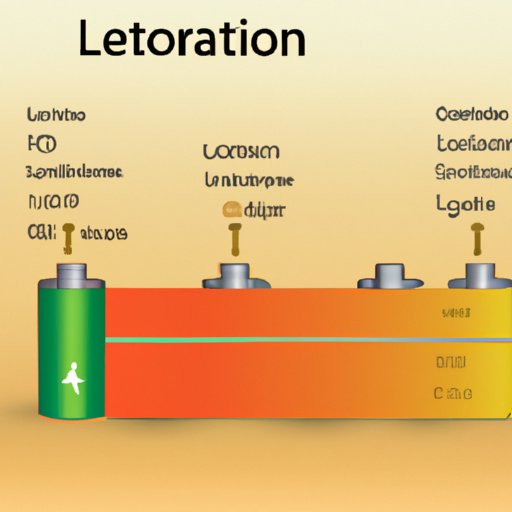Introduction
A lithium ion battery is a rechargeable power source used in many everyday devices, from smartphones to electric vehicles. This article explores how a lithium ion battery works, delving into the chemistry and components behind the technology as well as its advantages and applications.
Exploring the Basics of a Lithium Ion Battery
So, what is a lithium ion battery? In simplest terms, it is a type of rechargeable battery that uses lithium ions to store energy. Lithium is a lightweight metal with the highest electrochemical potential of any element, making it an ideal material for use in batteries.
The basic principle behind a lithium ion battery is that when a chemical reaction occurs between two electrodes (the anode and cathode), a flow of electrons is produced. This flow of electrons generates electrical energy, which can then be used to power devices.

How Rechargeable Lithium Ion Batteries Work
Rechargeable lithium ion batteries are composed of three main components: the anode, cathode and electrolyte. The anode is made of graphite and is the negative electrode of the battery. The cathode is typically made of a lithium compound such as lithium cobalt oxide or lithium manganese oxide, and is the positive electrode of the battery. Finally, the electrolyte is a liquid or gel that allows the movement of lithium ions between the anode and cathode.
When the battery is charging, lithium ions move from the anode to the cathode, storing energy in the form of chemical bonds. When the battery is discharging, the lithium ions move back to the anode, releasing energy in the form of electricity. This process can be repeated numerous times, allowing the battery to be recharged and reused.
The Chemistry Behind Lithium Ion Batteries
To understand how a lithium ion battery works, it is important to understand the chemistry behind it. The chemical reaction that takes place during charging and discharging is known as intercalation. During charging, lithium ions move from the anode to the cathode, where they become stored in the cathode’s crystal lattice structure. During discharging, the opposite process takes place, with the lithium ions moving from the cathode back to the anode.
According to research conducted by the University of California, Berkeley, the key to the success of lithium ion batteries lies in their ability to reversibly store and release lithium ions. This means that the same battery can be charged and discharged multiple times without degrading, making them ideal for powering small, portable devices.

Understanding the Components of a Lithium Ion Battery
In order for a lithium ion battery to work, all of its components must be able to work together effectively. The anode and cathode are the most important components, as they are responsible for storing and releasing energy in the form of lithium ions. Other components include a separator, which prevents short circuits, and a current collector, which helps to direct the flow of electrons.
The components of a lithium ion battery also play a role in determining the battery’s capacity and performance. For example, a battery with a higher capacity will be able to store more energy and last longer than one with a lower capacity. Additionally, the size and shape of the components can affect the battery’s weight and size, which is important for portable devices.

Discovering the Benefits of Lithium Ion Technology
One of the main advantages of using lithium ion batteries is their high energy density. Compared to other types of rechargeable batteries, lithium ion batteries can store more energy in a smaller package. This makes them ideal for powering small devices such as smartphones, tablets and laptops.
Additionally, lithium ion batteries are much lighter than other types of batteries, making them perfect for use in portable devices and electric vehicles. According to a study published in the Journal of Power Sources, lithium ion batteries offer up to five times more energy per unit weight than lead-acid batteries.

Analyzing the Pros and Cons of Lithium Ion Batteries
Although lithium ion batteries offer many advantages, there are also some drawbacks to consider. One of the main disadvantages is their cost. Lithium ion batteries are more expensive than other types of batteries, such as lead-acid batteries. Additionally, they are sensitive to temperature and can be damaged if exposed to extreme temperatures.
Despite these drawbacks, the benefits of lithium ion batteries far outweigh the cons. Their high energy density and light weight make them ideal for powering small devices and electric vehicles, while their long life cycle and low maintenance requirements make them a cost-effective choice in the long run.
Examining the Latest Advances in Lithium Ion Battery Technology
The latest advances in lithium ion battery technology have enabled new applications and improved performance. Recently, researchers have developed new materials that can increase the energy density of lithium ion batteries, making them even more efficient. Additionally, new technologies such as solid-state batteries are being developed which could potentially make lithium ion batteries even more powerful and reliable.
These advances in lithium ion battery technology have enabled new applications, such as electric vehicles and grid-level energy storage. As the technology continues to improve, we can expect to see even more applications for lithium ion batteries in the future.
Conclusion
Lithium ion batteries are a powerful and efficient type of rechargeable battery, offering many advantages over other types of batteries. By understanding the chemistry, components and benefits of lithium ion technology, it is possible to take advantage of this cutting-edge technology and power a variety of devices.
From smartphones to electric vehicles, lithium ion batteries are becoming increasingly commonplace. As technology continues to advance, we can expect to see even more applications for this versatile and powerful technology.
(Note: Is this article not meeting your expectations? Do you have knowledge or insights to share? Unlock new opportunities and expand your reach by joining our authors team. Click Registration to join us and share your expertise with our readers.)
